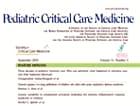Abstract and Introduction
Abstract
Objectives: To evaluate the impact of implementing an enteral nutrition algorithm on achieving optimal enteral nutrition delivery in the PICU.
Design: Prospective pre/post implementation audit of enteral nutrition practices.
Setting: One 29-bed medical/surgical PICU in a freestanding, university-affiliated children's hospital.
Patients: Consecutive patients admitted to the PICU over two 4-week periods pre and post implementation, with a stay of more than 24 hours who received enteral nutrition.
Interventions: Based on the results of our previous study, we developed and systematically implemented a stepwise, evidence and consensus-based algorithm for initiating, advancing, and maintaining enteral nutrition in critically ill children. Three months after implementation, we prospectively recorded clinical characteristics, nutrient delivery, enteral nutrition interruptions, parenteral nutrition use, and ability to reach energy goal in eligible children over a 4-week period. Clinical and nutritional variables were compared between the pre and postintervention cohorts. Time to achieving energy goal was analyzed using Kaplan-Meier statistical analysis.
Measurements and Main Results: Eighty patients were eligible for this study and were compared to a cohort of 80 patients in the preimplementation audit. There were no significant differences in median age, gender, need for mechanical ventilation, time to initiating enteral nutrition, or use of postpyloric feeding between the two cohorts. We recorded a significant decrease in the number of avoidable episodes of enteral nutrition interruption (3 vs 51, p < 0.0001) and the prevalence and duration of parenteral nutrition dependence in patients with avoidable enteral nutrition interruptions in the postintervention cohort. Median time to reach energy goal decreased from 4 days to 1 day (p < 0.0001), with a higher proportion of patients reaching this goal (99% vs 61%, p = 0.01).
Conclusions: The implementation of an enteral nutrition algorithm significantly improved enteral nutrition delivery and decreased reliance on parenteral nutrition in critically ill children. Energy intake goal was reached earlier in a higher proportion of patients.
Introduction
Enteral nutrition (EN) is the preferred mode of nutrient intake in critically ill children with a functioning gut.[1] In a recent international study of nutrient intake in mechanically ventilated patients, we reported a significantly lower odds of 60-day mortality in patients with greater adequacy of enteral nutrient delivery.[2] However, despite the preference for EN, there are a number of avoidable barriers in the PICU that impede optimal nutrient delivery at the bedside.[3] Delay in initiating and advancing EN can result in failure to reach energy and protein delivery goals.[4] In a previous study of nutrient delivery in our PICU, enteral feeds were started early after admission in a majority of patients but subsequently interrupted for a variety of reasons.[5] Many of the interruptions were related to the absence of a clear and uniform definition of feeding intolerance, prolonged nutrient deprivation surrounding routine procedures, and mechanical problems with feeding tubes.
There is currently no widely accepted or uniform approach to feeding the critically ill child. The lack of a strong evidence base for bedside nutrition practices in the PICU often results in heterogeneity of nutrition delivery. Algorithms may help optimize nutrient delivery and allow identification of best practices that are associated with desirable outcomes. A small number of institutions have reported significant improvement in nutrient delivery in their PICU after implementing nutrition guidelines.[6–8] Stepwise advancement of EN has been shown to significantly decrease the time required to achieve goals in this population.[8] Encouraged by the experience of these centers, we developed a comprehensive goal-directed EN delivery guideline based on local practice deficiencies identified in our preimplementation audit, a systematic literature search, and multidisciplinary consensus. The objective of our current study was to evaluate the impact of implementing this algorithm on achieving optimal EN delivery in the PICU. We hypothesized that implementation of a uniform nutrition guideline would decrease avoidable EN interruptions, increase likelihood of reaching energy delivery goals early via the enteral route, and decrease unnecessary reliance on parenteral nutrition (PN) in the PICU.
Pediatr Crit Care Med. 2014;15(7):583-589. © 2014 Lippincott Williams & Wilkins








